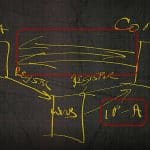Windows Troubleshooting Tip – NSLookup
Windows Troubleshooting Tip – NSLookup
I’ve published a number of articles on following a simple and straightforward troubleshooting methodology. I advocate a simple and focused approach shown in Figure 1. You can see that symptom identification is the first step, followed by root cause analysis and problem resolution.

Figure 1. MikeDan’s Quick and Dirty Troubleshooting Methodology.
There’s lots of great tools built right in to Windows that will actually help when narrowing down network communications problems. One of my favorites is NSLookup.
What is NSLookup?
Short for Name Server Lookup, NSLookup.exe is a command-line tool that queries a Domain Name System (DNS) server. Most Windows computers use DNS as part of, if not their primary and only means of resolving network names to IP addresses and locating network services like Active Directory.
When you’re troubleshooting a network communication issue like a client not reaching a web site or an application not finding a network server, you might split the possible causes into two questions:
1. Can the client resolve the server name to an IP address?
2. Can the client reach the resolved IP address?
NSLookup runs any DNS query that you want. So it directly contributes to answering the first question. There’s no sense trying to ping or open a SMB connection to a server (both of those steps assume name resolution works!) if name resolution is failing.
How Do I Use It?
Easy enough. These steps are written for Windows 7 but will work for virtually any version from Windows 2000 onwards.
1. Open a command prompt and type NSLookup. You’ll see the name and IP address of the primary DNS server configured on the computer as shown in Figure 2.
Figure 2. The default NSLookup output.
2. Type the name of the target server you’re trying to reach and press Enter. In this example I’m troubleshooting connection issues to two computers: ISOServer and smartboard1-pc. So I just type their names one at a time, and each time DNS is queried and the result is provided.
Figure 3. ISOServer has no DNS entry and smartboard1-pc does.
3. To check a different DNS server’s records for the same systems I tell NSLookup to use a specific server. In this example I use the DNS server at 10.1.0.100 and then re-run the queries as shown in Figure 4.
Figure 4. No results for either computer.
4. I compare the results of these NSLookup queries against the known configuration or against a computer that’s not exhibiting the same symptoms.
5. Note that I ran queries for internal resources against internal DNS. I can also run queries for external servers against either internal or external DNS. For example, in Figure 5 I query the public DNS provided by Level 3 for the IP address of http://www.yahoo.com/. I then compare it against my internal DNS resolution.
Figure 5. Name resolution consistency between DNS servers tends to rule out name resolution issues.
Comparing results between DNS resolvers and queries helps me either rule out name resolution or target it as a likely culprit.
Mike Danseglio -CISSP / CEH
Interface Technical Training – Technical Director and Instructor
You May Also Like
DNS, DNS resolvers, external DNS, internal DNS, Name Server Lookup, nslookup
A Simple Introduction to Cisco CML2
0 3896 0Mark Jacob, Cisco Instructor, presents an introduction to Cisco Modeling Labs 2.0 or CML2.0, an upgrade to Cisco’s VIRL Personal Edition. Mark demonstrates Terminal Emulator access to console, as well as console access from within the CML2.0 product. Hello, I’m Mark Jacob, a Cisco Instructor and Network Instructor at Interface Technical Training. I’ve been using … Continue reading A Simple Introduction to Cisco CML2
Creating Dynamic DNS in Network Environments
0 642 1This content is from our CompTIA Network + Video Certification Training Course. Start training today! In this video, CompTIA Network + instructor Rick Trader teaches how to create Dynamic DNS zones in Network Environments. Video Transcription: Now that we’ve installed DNS, we’ve created our DNS zones, the next step is now, how do we produce those … Continue reading Creating Dynamic DNS in Network Environments
Cable Testers and How to Use them in Network Environments
0 727 1This content is from our CompTIA Network + Video Certification Training Course. Start training today! In this video, CompTIA Network + instructor Rick Trader demonstrates how to use cable testers in network environments. Let’s look at some tools that we can use to test our different cables in our environment. Cable Testers Properly Wired Connectivity … Continue reading Cable Testers and How to Use them in Network Environments








